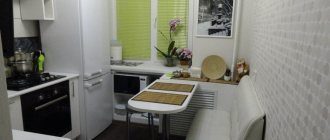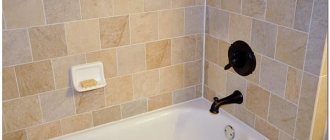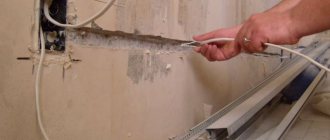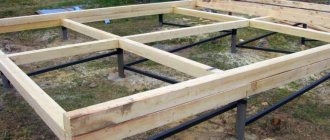When determining what the distance between the refrigerator and the wall should be, most consumers believe that this is not a fundamental issue and is of little importance. Statistics collected from the general experience of manufacturing companies show that the location of a refrigerator plays a huge role in its ability to operate smoothly. Failure to comply with operating rules is the path to rapid failure of the most reliable unit. The work of repairmen who provide warranty repairs to a conventional refrigerator only confirms the existing dependence on the distances to the wall on the side and back.
In the kitchen
Facades and doors of built-in refrigerators
Each built-in model is accompanied by an installation diagram or annotation, which carefully indicates the dimensions of the facade and doors for the given parameters of the device.
The width of the cabinet for installation should be 2-3 cm greater than the width of the refrigerator. For the most popular two-chamber model Liebherr IKB 3560 with a standard width of 55.9 cm, the door width should be from 56 to 57 cm.
It is recommended to choose the thickness of the door itself in the range from 16 to 19 mm, the width of the gap between the doors of the refrigerator and the cabinet is not less than 3 mm. It is important that the weight of the door does not exceed the values indicated in the annotation for each model.
The facade must be selected so that it completely covers both the door of the device and the gaps to the side walls of the cabinet. The method of fastening the facade is also indicated in the annotation. Some provide a separate installation diagram for the front panels indicating all dimensions.
Tips for choosing a freezer
You shouldn’t get hung up on a certain model just out of respect for the country of origin, a previously favored brand that gained trust due to the long-term use of the previous model.
The most proven and reliable equipment easily fails, and the required clearances specified in the instructions are based on the design features of a particular refrigerator, its cooling and heating, as well as the location of the main heat dissipation zone.
If it's about saving space, it may be worth looking at a narrower model from a trusted designer rather than skimping on the recommended distance from the wall to the refrigerator. Deviations from the required standard quickly lead to the need for repairs, and if it is determined that the breakdown is due to improper operation, repairs can be very expensive.
Standard sizes of built-in refrigerators
First, the depth of the product is standardized - this is necessary to create a level facade. A refrigerator built into a cabinet has a depth of about 55 cm.
Devices under the countertop are installed on the floor and have a depth of 55 to 57 cm. Usually, they are supplemented with side walls. For small refrigerators placed in a niche, the depth also ranges from 55 to 57 cm.
The standard width of all types of devices is 54-56 cm. It is also selected taking into account the usual width of kitchen cabinets (about 60 cm) and the gaps between the cabinet and the refrigerator.
The width of unusual devices - for example, Side-by-Side - can range from 70 to 120 cm. For example, the KitchenAid KCBPX 18120 model with a useful volume of 615 liters has a width of 120 cm.
The height of the device is a more flexible indicator. It varies from 50 to 220 cm. In terms of height, several groups can be distinguished:
- mini-refrigerators under the countertop - up to 82 cm;
- medium models - up to 150-170 cm;
- the tallest huge refrigerators for installation in a cabinet or column - up to 210 cm.
Parameters of built-in Side-by-Side refrigerators
Side-by-Side refrigerators with 2, 3 or 4 chambers are suitable for large families, anyone who likes to do homemade preparations, and those who have their own homes and apartments with a large kitchen.
There are not many built-in “Side-by-Side” models, but they all belong to the luxury class and attract with a large capacity of up to 600 liters, a freezer compartment volume of over 300 liters, and amazing internal filling.
The width varies from 90 to 120 cm, and the height from 177 to 202 cm.
What to do if the layout is unsuccessful
In small rooms it is not always possible to follow all the rules listed above. You have to install the device near a window or next to a heating riser. But even here there is a way out.
To avoid overheating the refrigerator, it is enough:
- hang blinds or roller blinds on the window;
- insulate the heating riser;
- move the radiator away from the device.
In the most difficult cases, redevelopment will help: combining the kitchen with the living room, moving the doorway, etc. A standard refrigerator fits perfectly into the passage to a small kitchen - this opening is sewn up in the form of a niche. A new doorway is punched into the adjacent partition.
What sizes are built-in refrigerators?
An integrated refrigerator is a successful find for the kitchen. It does not violate the overall style, does not block the passage, as it is installed as a single façade with other furniture. The walls of a cabinet or cabinet reduce noise levels and also help save energy because they serve as additional thermal insulation.
Modern embedding technologies make it possible to install devices of any type and size in the kitchen, including extraordinary ones. In cabinets or cabinets you can place a single-chamber, double-chamber and even a huge Side-by-Side model. Each of them, together with an annotation, is accompanied by an installation diagram indicating all dimensions.
Alternative accommodation
Where else can you place a refrigerator if it doesn’t fit in the kitchen? The answer suggests itself: in the nearest premises. Of course, the ergonomics of the kitchen will suffer greatly from this, but it is better than living without a refrigerator at all.
Corridor
The corridor is most suitable for placing the device: there are no windows or heating radiators, and the air temperature is noticeably lower than in the kitchen. The device will work more economically. The main task is to find a suitable place.
In order not to disturb the style of the interior, choose a built-in model. It has a smaller volume compared to a free-standing device, but will easily fit into any closet.
Cold storage areas are also placed separately: for example, a freezer is in the hallway, and a compact refrigerator is in the kitchen under the countertop, or vice versa.
Pantry
If a small kitchen is adjacent to a pantry, it would be a shame not to use it by connecting it to the kitchen. This will make a great niche for a refrigerator.
If this is not possible, use it without redevelopment, connecting it to the corridor: just remove the door and design the opening in the form of an arch, behind which the refrigerator will stand.
Bathroom, balcony or loggia
These rooms are absolutely not suitable for installing a refrigerator for the following reasons:
- Inappropriate temperature conditions.
- High humidity.
- Presence of direct sunlight (on the balcony or loggia).
Other rooms
Any refrigerator, even a built-in one, operates with a certain noise level. This is especially noticeable at night. Therefore, placing it next to the bed is not recommended. Carrying groceries across the hallway is far and inconvenient.
Dimensions of built-in single-chamber refrigerators
Built-in refrigerators with 1 chamber include devices without freezers, models with a small freezer in the upper part and freezers. Most models have a standard width of 55 to 60 cm and a depth of 54.4 to 55 cm.
The height of single-chamber models can be very different:
- from 50 to 70 cm - for minibars and freezers;
- 82 cm - for small refrigerators under the countertop;
- 100-140 cm - for models without a freezer;
- 177 cm - for full-size models with a freezer compartment;
- 200-215 cm - for huge freezers and devices without a freezer.
Cabinets, niches, boxes
The cabinet, niche or box where the unit is installed is also subject to a number of safety requirements, which are usually indicated in the installation instructions or installation diagram.
What are the gaps between the facades in the kitchen? And how to calculate the facades?
In general, the cabinet has a base height of more than 2 cm and a back wall with ventilation holes. Small ventilation area through the base - 200 sq. cm. A mezzanine can be placed on top, the dimensions of which are determined by the height of the room.
The distance to the back wall of the cabinet from the refrigerator should be more than 5 cm. A gap of 1 cm is also needed between the refrigerator and the mezzanine. The total height of the cabinet or niche should exceed the height of the refrigerator by 8 cm.
From time to time, a free-standing refrigerator is placed in a box or niche in the kitchen unit. In this case, the dimensions of the box or niche should also provide for ventilation:
- When installing in a box, which is often done by hand, it is necessary to leave a gap of 5 to 10 cm between the rear walls of the device and the box.
- If there is no back wall, it is necessary to maintain a distance between the refrigerator and the wall for free air circulation.
- If a niche is selected for installing the unit, then first determine its depth, which should be 8-10 cm greater than the standard depth of the device, equal to 60 cm.
- The distance to the side walls, as well as to the ceiling of the niche, should be more than 10 cm so that the device can be easily installed in it.
- Often, a refrigerator in a niche or box is placed on a podium (base), in which ventilation holes are also drilled.
Advantages
- First of all, it is worth noting that these niches are often used in the construction of buildings . They are manufactured according to a pre-marked project, using drywall, in order to significantly reduce production time and make it possible to deliver the object on time.
- Also, the use of this material allows you to save a lot on large volumes . This is achieved by excluding from the estimate such work as plastering and puttying. The walls are leveled by drywall workers at the final stage of the work.
- It is worth noting that having learned how to make niches from plasterboard with your own hands, it immediately becomes clear that this work requires only one skilled craftsman and can be completed in one day.
Advice! All the advantages of such a design associated with cost savings will only be noticeable on a large volume of work. At the same time, on a small scale, plasterboard structures retain the advantages associated with speed and ease of installation.
Plasterboard niches in the form of a cabinet
Installing a built-in refrigerator in a kitchen unit
You have probably more than once had to create (maybe live, or maybe in photos) kitchens that include a pencil case with a refrigerator inside.
At the same time, the pencil case is locked with the same facades as in the entire kitchen. It looks very nice and is comfortable to use.
What do you need to know when designing such headsets?
The most important thing that you need to realize is that you cannot build an ordinary refrigerator into a kitchen cabinet so that it can be locked from the outside, the kitchen facades.
This type of equipment has space for fastening kitchen facades (on all opening doors), plus it comes complete with the fastener itself and a diagram for its installation.
Therefore, before making such projects of kitchen units, it is necessary, first, to have in hand an annotation for the built-in appliances, according to which it is necessary to design the cabinet itself, and decide on the dimensions of the fronts on the doors of a certain device.
You should also not forget that different manufacturers have different installation schemes (as well as the fittings themselves).
Therefore, you should not engage in “independent creativity”; nothing good will come of it.
A few more words about the hinges and fasteners that come with the equipment we are considering.
The fronts are attached to the boxes with ordinary hinges, but they are already attached to the doors of the refrigerator itself with a special device similar to guides.
When you open the door using these guides, the facade seems to slide relative to it.
In addition, the function of opening a door with a facade attached to it (described above) can be done by special hinges that are attached to the refrigerator, to the box in which it is built and to the door with the facade.
In appearance, they are steel, powerful, and, at first glance, quite reliable. But they all have one weak point: this is the mechanism inside the hinge, which includes plastic spring holders.
It is this “weak link” (plastic holders) that fails.
From time to time they break, perhaps because their design is far from perfect (an example of this is plastic components), or because they hold the entire door, which, in turn, can be additionally loaded with products stored in the refrigerator itself.
How to install a built-in refrigerator
If one loop fails, it is necessary to immediately change the entire set, because the second one, in this case, will definitely break.
This article discusses options for refrigeration equipment built into kitchen cabinets specially made for them.
There is also such a technique that is built specifically under the countertop of a kitchen unit, but this is a topic for a separate article.
READ Which odor absorber is best for the refrigerator?
Insulation of an electric refrigerator from a radiator
To provide the refrigerator with the necessary operating conditions, it is important to protect it from the influence of the radiator.
There are several ways to protect the unit:
- Mount the battery box.
- Wrap part of the pipe with heat-insulating material - foamed polyethylene, penofol, mineral wool.
- Install a protective foil wall above the radiator level.
- Use a screen made of durable glass.
- Place a rattan or polymer case on the battery.
- Install an additional hood above the refrigerator, venting into the air conditioning system.
- Place the equipment diagonally in relation to the heat source.
Such measures do not require a lot of time and money. But they prevent overheating, premature wear of the compressor, and save the family budget, which would have to be spent on repairing equipment, paying for electricity or purchasing a new cooling system.
The most difficult problem that owners of a brand new refrigerator have to solve is how to balance all the requirements and take into account the nuances. To do this, you need to prioritize and highlight what is suitable for the conditions of a particular home. The main thing is that the refrigerator fits and can work. We add criteria related to wear reduction, ease of use and solutions that improve aesthetics. That's all! Your faithful friend is ready to serve for many years and please the eye.
Cabinet for a built-in refrigerator and a regular one: all furnishing options for the kitchen
A kitchen set with home appliances integrated under the countertop looks like a single whole. But the refrigerator often stands out from the overall kitchen interior design if possible design options are not thought out in advance. You can make a cabinet for a built-in refrigerator with a closed door - and from the outside it will look like a single part of the kitchen. They fit perfectly into cabinets and ordinary refrigerators, the main thing is to take into account several aspects and avoid common mistakes.
Cabinet dimensions for built-in refrigerator
Typically, all “built-in” kitchen appliances are designed for the depth of standard modules – 550-560mm. Built-in refrigerators are no exception. They are also designed for a cabinet depth of 560mm, and when designing, you can align the front part of the cabinet with the rest of the kitchen unit modules.
The width of the cabinet for a built-in refrigerator is about 600mm. The internal size is important here (minimum 560-570mm for most models), and the external size is determined by the width of the body material and standards for facades, if any.
For example, in the line of standard facades there may be a door option with a width of 596 mm, but manufacturing an unusual size will cost 10-20% more. In this case, they try to use an economical option for equipping the kitchen.
In the near future, the so-called Gola profile has become popular in the design of kitchen furniture without handles. The first ones are applied to the facade , and the second ones are built into the body of kitchen cabinets and hanging cabinets. For pencil cases, vertical placement of Gola-type handles is typical - which means that the width of the cabinet for a built-in refrigerator will increase by the width of the profile handle. With expensive profile handles in a horizontal design, it is important to correctly calculate the height of the facades for correct opening.
The internal design of the cabinet for a built-in refrigerator should provide for self-cooling of the operating unit due to air circulation. The installation diagrams indicate the required gaps and cuts in the housing for this. When designing a pencil case, they must be observed.
You can use a special tray with ventilation holes as the bottom for the cabinet under the refrigerator. It will cost a little more. Also on sale in kitchen devices there are special ventilation grilles for the design of the refrigerator base.
Two cabinet designs for a built-in refrigerator are more common. How to install a refrigerator in a cabinet is largely determined by the installation diagram from the manufacturer:
- Do I need to raise the base to a height of 200mm and leave a gap for ventilation at the top?
- Or you can simply select a niche of the required size inside (1770x540x540).
The height of the cabinet can be any, as desired. Most often it is made level with the hanging of the upper kitchen cabinets, within 2000-2400mm from the floor level. As you can see in the drawing, there is no back wall of the cabinet for the built-in refrigerator .
Dimensions of fronts for a cabinet with a built-in refrigerator
Depending on the model, a built-in refrigerator may have one solid overlay door or two separate doors located one above the other.
facade is also placed on two doors , but this is inconvenient for further use.
When calculating the dimensions of facades for a built-in refrigerator, they also rely on data from the installation diagram of a specific model. Usually they try to align the lower facade in height with the rest of the facades of the floor cabinets. But if the kitchen countertop is raised to the level of 900-950mm, this is not always possible. But it is easy to “adjust” to the 850mm standard with a height of 720mm lower modules without legs. Thanks to this, the kitchen design looks holistic and harmonious.
Practical advice
The installation features also depend on the specific model of the device - overheating is most dangerous for “delicate” and “smart” imported equipment. The more powerful the refrigerator, the larger the recommended gap between it and other pieces of furniture. To prevent the product from deteriorating during operation, the serviceability of the electrical wiring is checked in advance, high-quality grounding is carried out, and stabilizers are installed that can prevent damage that inevitably occurs during sudden changes in voltage in the network.
Before installation, it is necessary to check the serviceability of the electrical wiring.
During transportation to its destination, the refrigerator should not shake excessively, which often happens when delivered from afar, on roads with many potholes. It is recommended to secure the product firmly and not remove it from the original packaging, where foam is placed in the right places. After unloading, but before connecting, the item should remain in the room for six to eight hours.
The back of the refrigerator should never touch the wall.
How to make a cabinet if the refrigerator is not built-in?
The main rule that should be followed in any case of building a refrigerator into a cabinet is not to place it next to an oven, microwave or microwave oven, or any heating household appliance. The fact is that modern models of refrigerators and freezers do not have evaporators at the back; as a rule, they are built into the “sides.” And for the refrigerator to operate correctly, its sides must self-cool through free air circulation. And not to be heated by the “neighbors” standing close to each other. This may negatively affect the service life.
Almost any refrigerator can be installed in a cabinet. How to close it with a door. The main thing is to carefully read the technical data sheet and follow all recommendations regarding the size of the gaps between the side walls of the cabinet (or wall niches, if the refrigerator is built into a niche).
Where to begin?
Before proceeding directly with installation, you must read the attached instructions. As a rule, some modern models may have additional requirements that must be met. Devices that support the latest features (such as smart refrigerators) require additional installation conditions to optimize their performance. Even before purchasing, it is worth studying the requirements for the place of their installation.
Before directly installing the refrigerator, you should definitely check the power cable for manufacturing defects and damage. If deep scratches or other defects are noticed, it is recommended not to use it but to replace it immediately. This will prevent a power failure that could cause serious damage. The refrigerator is installed in a pre-prepared place. The most important thing is that it is even (to avoid skew).
How best to “fit” a refrigerator into the kitchen interior
The housewife has the opportunity to purchase all household appliances decorated in the same style and shade in the case of a one-time, simultaneous purchase. Otherwise, choosing a suitable non-built-in refrigerator can be problematic. And it looks like something alien in the kitchen.
There is a way out - this is to decorate an ordinary refrigerator to match the interior of the kitchen.
Or add cabinets and shelves above it in the same design as the kitchen furniture.
READ Dry freeze refrigerators pros and cons
But if possible, it is better to make a closed cabinet for the built-in refrigerator. Moreover, build in an ordinary refrigerator , the main thing is to follow all the manufacturer’s installation recommendations.
Cabinet dimensions for a built-in refrigerator
If a regular refrigerator into a niche or cabinet, be prepared to allocate space for it “with reserve”. As a rule, the cabinet width for a built-in refrigerator of a conventional model ranges from 700-800mm. At the same time, if you want to close it with a door, the depth along the body is also made with a margin.
If a cabinet with a built-in refrigerator is located in the same row as a kitchen unit, options with a depth of 600 mm - flush with the kitchen countertop - look harmonious. In this case, the cabinet body itself will have no door.
In this case, be prepared to provide a recess in the body of the refrigerator case for opening the refrigerator door. However, it all depends on the model - in some cases such a trick is not required.
Avoid proximity to gas stoves and radiators
Installing a refrigerator in the kitchen always involves the risk that it will be installed in close proximity to a stove or radiator. In most cases, this is what happens, since not every kitchen has space for “creativity.” But it is advisable to avoid this, since such an installation will cause excessive overheating of the equipment.
If proximity to a hob or radiator cannot be avoided, make sure there is a protective barrier. It can be an ordinary sheet of plywood with a layer of foil, which perfectly reflects heat. In addition, it is not advisable to install the refrigerator under direct sunlight.
Make sure that the refrigerator compartment is located away from devices with natural grounding - such proximity will have a bad effect on the efficiency of the equipment, and also contradicts safety precautions when working with electrical appliances. If this cannot be avoided, enclose the naturally grounded device with a thin lattice of wood.
If a refrigerator is installed in a cramped kitchen, many owners seek to save space and integrate it into the furniture. This is quite acceptable, but only if there are gaps. There are refrigeration units in which the compressor and fan are located at the bottom - such devices are quite suitable for installation close to the walls.
After purchasing new household appliances, a large number of consumers have to pay for additional services of specialists for installation or installation of the device. Although some work can be done independently, without the help of qualified craftsmen. For example, installing a refrigerator, especially a freestanding one, does not require special experience. Even a built-in device can be installed without any skills; just read the general recommendations and advice from experts.
How to make a cabinet for a built-in refrigerator
The design of the cabinet-case for the built-in refrigerator is extremely simple and straightforward. This is the same cabinet, with a bottom and adjustable legs, like the other floor modules of the lower row of the kitchen. And the remaining dimensions of the pencil case are determined by the drawings in the instructions supplied with the refrigerator. Often in modular kitchens such as Ikea and Leroy, ready-made modules of pencil cases for built-in refrigerators are provided. They are designed to fit most models and can easily be adapted to others. Before purchasing, make sure your refrigerator model is one of them.
Cabinet for built-in refrigerator. How to design correctly?
Almost all refrigerators have a kitchen cabinet front width of 600mm.
This is the standard and in most cases you should not deviate from it.
How to install a built-in refrigerator in the kitchen. Master Class. Door sliding system
The kitchen cabinet for the refrigerator is designed with a regular bottom on regular kitchen legs. Sometimes, instead of a bottom, you can install plastic bottoms with ventilation holes. They are supplied by various suppliers. If the bottom of the cabinet for the kitchen built-in refrigerator is made of the same material as the kitchen itself, for example from MDF, then it is necessary to plan ventilation holes in this bottom. There is no plan for a back wall in the cabinet for the built-in refrigerator.
The depth of the kitchen cabinet for the built-in refrigerator is planned to be 560 mm. The height of the lower facade along the body should be 720 mm, the height of the upper facade along the body should be at least 1200 mm. The total height of the case is 1920 mm. A standard built-in refrigerator will fit very well there (not all are standard, read about that below).
Cabinet for built-in refrigerator
Articles on modern kitchens:
Below are shown standard refrigerators for the specified parameters.
The above two-chamber refrigerator looks like a two-door one both when closed and open.
Articles on kitchens in the modern classic style:
a single-compartment refrigerator looks like a two-door one, but when open, you can see that both furniture doors are essentially hanging on one single refrigerator door. However, such cabinets are designed with two doors so that they look logical and beautiful with other nearby kitchen cabinets. And it will always be right to design a small shelf into this cabinet, which will be placed inside the cabinet on top of the refrigerator. Such a shelf is usually installed locally when it is possible to clearly compare the parameters of the refrigerator and cabinet.
The cabinet cover for a built-in refrigerator should be designed so that it does not reach the wall by 50 mm. As a result, the temperature from the operation of the refrigerator will escape over the kitchen.
The plinth, which covers the front of the cabinet for the built-in refrigerator , must have ventilation holes. This can be a grille in the form of a separate element, or it can be holes in the base (bottom bar).
When designing a cabinet for a two-door refrigerator, you should check the parameters of the refrigerator doors and cabinet doors very carefully. The main thing is that they match in height and can open correctly after installation. I wrote at the beginning that the standard height of the bottom door on the body is 720 mm.
However, there are refrigerators with a lower door height greater than 720 mm. If this subtle point is not taken into account, then the correct joining of the cabinet doors and refrigerator doors will not occur. This error leads to the fact that the lower and upper doors of the refrigerator only open together at the same time. And it’s very strange when you can’t open the freezer separately. So don't make this mistake.
Sources:
https://www.sdmeb.ru/kuxni/ustanovka-vstroennogo-xolodilnika.html https://shkaf-info.ru/shkaf-dlya-vstroennogo-holodilnika-i-obychnogo-vse-varianty-obstanovki-dlya-kuhni / https://dd-space.com/chastye-voprosy-professionalov/shkaf-pod/
Electrical connection
Before installing a set of furniture in the kitchen, you need to decide where the built-in refrigerator will be connected. It is best to install a separate electrical outlet with a grounding contact for this purpose, and, if necessary, install wires from the electrical panel or junction box. The conductor cross-section must be selected in accordance with the electrical power of the load. If a group of sockets is being installed and it is intended to install and connect several electrical appliances, for example, a built-in refrigerator, hob and oven, then when choosing the cross-section of the supply wires, their total power should be taken into account. It is better to choose the location of the outlet (or outlets) so as not to occupy open parts of the wall and at the same time ensure accessibility. For example, it is convenient to install sockets under the countertop, where they will not interfere, and equipment can be easily turned off when servicing it.
The diagram below shows the optimal locations for installing sockets in the kitchen:











